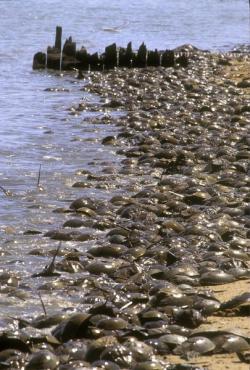
Every spring, John Rodenhausen looks forward to seeing a few horseshoe crabs on the beach at the Chesapeake Bay Foundation's headquarters outside Annapolis.
This year, Rodenhausen said, thousands of the prehistoric-looking creatures, which resemble spiders more than crabs, were mating on the Annapolis beach in late May. As is their wont, the smaller males attached to the larger female, sometimes four to five at a time — one large carapace surrounded by smaller ones, like points on a star.
"It blew us all away," said Rodenhausen, the foundation's Maryland development director. "You'll always see a few, and you might see a dozen, but we saw thousands. And it wasn't even a full moon."
Citizens and scientists are documenting large numbers of the spike-tailed, helmet-shelled creatures on Chesapeake Bay and Delaware Bay beaches. The uptick could be a sign that once-unpopular management restrictions are working and could help secure a future for the Atlantic Limulus polyphemus, long prized for what it could do for other species instead of for its own virtues.
The eggs that female horseshoe crabs lay on beaches feed large quantities of shorebirds, which can double their weight in two weeks of feasting, helping them to fly halfway around the world. Their copper-rich, blue blood can save human lives; scientists use a chemical found only in the species' blood to test for bacteria and identify potentially lethal contaminations in intravenous medications. For decades, companies took the animals to grind into fertilizer and raise food. Fishermen backed their trucks up to crab-rich beaches and took what they wanted to use as bait in the conch and eel fisheries.
But now, wildlife officials say, protections put in place in the last two decades could finally be stabilizing and even helping to rebuild the 450 million-year-old species. And the long unloved creature is finally getting some love — especially from those interested in watching some sex on the beach.
Read the rest of the story in Bay Journal here.
This year, Rodenhausen said, thousands of the prehistoric-looking creatures, which resemble spiders more than crabs, were mating on the Annapolis beach in late May. As is their wont, the smaller males attached to the larger female, sometimes four to five at a time — one large carapace surrounded by smaller ones, like points on a star.
"It blew us all away," said Rodenhausen, the foundation's Maryland development director. "You'll always see a few, and you might see a dozen, but we saw thousands. And it wasn't even a full moon."
Citizens and scientists are documenting large numbers of the spike-tailed, helmet-shelled creatures on Chesapeake Bay and Delaware Bay beaches. The uptick could be a sign that once-unpopular management restrictions are working and could help secure a future for the Atlantic Limulus polyphemus, long prized for what it could do for other species instead of for its own virtues.
The eggs that female horseshoe crabs lay on beaches feed large quantities of shorebirds, which can double their weight in two weeks of feasting, helping them to fly halfway around the world. Their copper-rich, blue blood can save human lives; scientists use a chemical found only in the species' blood to test for bacteria and identify potentially lethal contaminations in intravenous medications. For decades, companies took the animals to grind into fertilizer and raise food. Fishermen backed their trucks up to crab-rich beaches and took what they wanted to use as bait in the conch and eel fisheries.
But now, wildlife officials say, protections put in place in the last two decades could finally be stabilizing and even helping to rebuild the 450 million-year-old species. And the long unloved creature is finally getting some love — especially from those interested in watching some sex on the beach.
Read the rest of the story in Bay Journal here.


 Advertising
Advertising